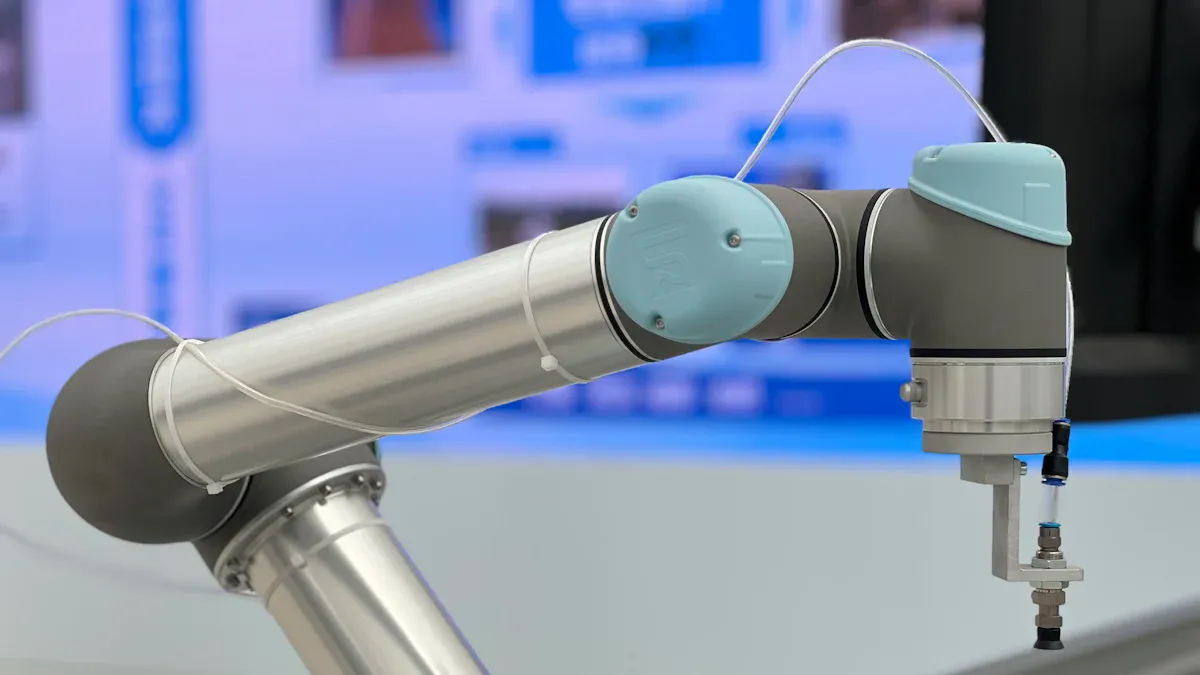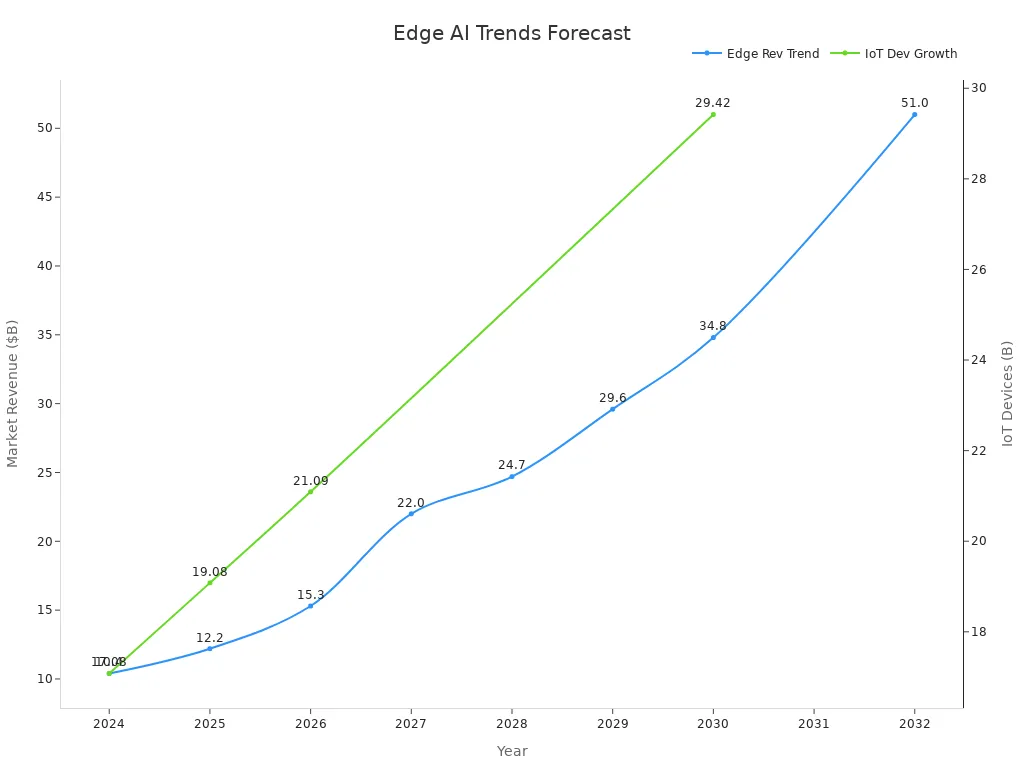A Beginner’s Guide to Edge AI Machine Vision System

Edge AI machine vision systems combine artificial intelligence with advanced visual processing to analyze images and videos directly on edge devices. These systems process data locally, enabling immediate insights without relying on cloud connectivity. This approach is transforming industries by delivering real-time results.
Adoption of these systems has surged globally. For example:
- The Edge AI software market is projected to grow from USD 2.40 billion in 2025 to USD 8.88 billion by 2031.
- Processing speeds have improved up to 32 times faster than traditional CPUs, enhancing factory operations by 30%.
North America leads this trend, holding over 35% of the AI in Vision market share in 2023 due to substantial investments in machine vision technologies.
Key Takeaways
- Edge AI machine vision systems work locally to give quick results. They don't need the internet or cloud to function.
- These systems help businesses work faster by checking things quickly and making fewer mistakes. They are useful in factories and hospitals.
- Using edge AI can save money by using fewer cloud services and managing resources better.
- Fast data analysis helps make better choices and react quickly to problems. This boosts how well things get done overall.
- Edge AI systems keep private data safe by storing it on-site. This lowers the risk of online attacks.
Understanding Edge AI Machine Vision System
Key components and technologies
An edge AI machine vision system relies on several key components and technologies to function effectively. These include:
- Edge devices: Devices like cameras, sensors, and processors capture and process data locally. They eliminate the need for constant cloud connectivity, enabling real-time operations.
- AI algorithms: Advanced algorithms analyze visual data, identifying patterns and making predictions. These algorithms often use machine learning and deep learning techniques to improve accuracy over time.
- Edge computing infrastructure: This infrastructure processes data at the edge, reducing latency and enhancing performance. It ensures that the system delivers insights quickly and efficiently.
- Computer vision technology: This technology enables machines to interpret and understand visual information. It plays a critical role in tasks like object detection, facial recognition, and quality inspection.
Edge artificial intelligence combines these components to create systems capable of processing data faster and more securely. For example, edge computing allows AI solutions to operate in environments with limited internet connectivity, such as remote factories or agricultural fields.
Integration of AI and machine vision
The integration of AI with machine vision has revolutionized how industries approach visual data analysis. AI solutions enhance the capabilities of machine vision by enabling systems to learn from data and adapt to changing conditions. This integration offers several benefits:
- Improved accuracy: AI-powered machine vision systems can detect even the smallest defects or anomalies, ensuring consistent quality.
- Faster processing: AI algorithms process images and videos in real-time, reducing inspection times and improving operational efficiency.
- Enhanced decision-making: By analyzing visual data instantly, these systems provide actionable insights that help you make informed decisions.
| Performance Indicator | Description |
|---|---|
| Incident Detection Times | Measures how quickly incidents are identified, enhancing response times. |
| Alert Accuracy | Evaluates the precision of alerts generated by the system. |
| Intervention Time Reduction | Assesses the decrease in time taken to intervene during incidents. |
| Compliance Monitoring | Tracks adherence to safety regulations, ensuring operational standards. |
AI solutions also improve safety by reducing the need for human intervention in hazardous environments. For instance, in manufacturing, AI-based computer vision systems monitor production lines to identify potential risks and prevent accidents.
Real-world examples of Edge AI machine vision systems
Edge AI machine vision systems have already demonstrated their value in various real-world applications. Here are some notable examples:
- Drone-based inspections: Hepta Airborne uses drones equipped with edge AI solutions to inspect power lines. This system checks 250 km of power lines in just 5 minutes, saving 3,000,000 euros annually compared to manual inspections. It also identifies 400% more unique defects, enhancing safety and efficiency.
- Cemetery mapping: Gratitude Services employs computer vision to create digital maps of cemeteries. This approach automates the detection and labeling of tombstones, streamlining navigation for users and reducing manual effort.
- Healthcare diagnostics: AI-powered systems analyze medical images, such as X-rays and MRIs, to detect diseases early. These systems provide real-time insights, enabling faster and more accurate diagnoses.

These examples highlight the transformative potential of edge AI machine vision systems across industries. By leveraging edge computing and artificial intelligence, these systems deliver real-time insights, improve efficiency, and reduce costs.
How Edge AI Machine Vision Systems Work
Data capture and processing mechanisms
Edge AI machine vision systems excel at capturing and processing visual data locally. You benefit from reduced latency and enhanced security because the data remains on edge devices instead of being transmitted to the cloud. This localized approach ensures real-time processing, which is crucial for applications like autonomous vehicles or industrial automation.
The advantages of these mechanisms become clear when comparing them to traditional cloud-based AI systems:
| Advantage | Edge AI Benefits | Traditional Cloud AI Drawbacks |
|---|---|---|
| Reduced Latency | Immediate analysis and response for time-sensitive applications. | Network delays hinder instant decision-making. |
| Enhanced Data Privacy and Security | Localized data processing minimizes exposure to cyber threats. | Data transmission increases compliance risks. |
| Cost Optimization and Efficiency | Lowers operational costs by reducing cloud dependency and optimizing resources. | Higher costs associated with data transmission and cloud resources. |
By leveraging edge computing, you can achieve faster insights and lower operational costs. For example, in manufacturing, edge AI machine vision systems detect defects in products instantly, reducing waste and improving efficiency.
Role of edge devices and sensors
Edge devices and sensors form the backbone of edge AI machine vision systems. These components capture high-quality visual data and process it locally, enabling real-time analysis. You can rely on these devices to reduce end-of-line testing by 30%, improve lead times, and lower remedial costs for defects.
Here’s how edge devices and sensors enhance performance:
- Reduction of end-of-line testing by 30%.
- Improved lead time for production processes.
- Lower remedial costs of defects.
- Real-time analysis enabled by localized data capture.
For instance, in smart cities, edge devices like traffic cameras analyze vehicle movements in real-time to optimize traffic flow. This reduces congestion and enhances mobility without relying on cloud-based systems.
AI algorithms for visual data analysis
AI algorithms are the driving force behind the intelligence of edge AI machine vision systems. These algorithms analyze visual data to identify patterns, detect anomalies, and make predictions. You benefit from their ability to process data quickly and efficiently, enabling real-time decision-making.
Empirical measurements highlight the performance improvements of AI algorithms across various edge devices:
| Measurement Type | TPU Devices | Raspberry Pi4 | Google Coral | Nvidia Jetson Nano | Other Devices |
|---|---|---|---|---|---|
| Inference/Execution Time | ✓ | ✓ | ✓ | ✓ | ✓ |
| Energy Consumption | ✓ | ✓ | ✓ | ✓ | ✓ |
| RAM Memory Consumption | ✓ | ✓ | ✓ | - | - |
| CPU Consumption | - | - | - | - | - |
| Tested with Different Models | ✓ | ✓ | ✓ | ✓ | - |
| EdgeFaaSBench Metrics | ✓ | - | - | - | - |
| YOLO Benchmark Performance | ✓ | ✓ | - | ✓ | - |
| DL Models Benchmark | - | - | - | ✓ | - |
| Latency, Memory, Power Usage | ✓ | - | - | ✓ | - |
These algorithms, powered by artificial intelligence, enable edge AI machine vision systems to deliver real-time processing and actionable insights. For example, in healthcare, AI algorithms analyze X-rays and MRIs to detect diseases early, improving patient outcomes.
Benefits of Edge AI Machine Vision Systems
Real-time insights and decision-making
Edge AI machine vision systems empower you with real-time insights that transform decision-making processes. By processing visual data locally, these systems deliver immediate feedback, enabling you to act quickly in dynamic environments. For example, in manufacturing, real-time monitoring of production lines helps identify defects instantly, reducing waste and improving product quality.
Real-time data analysis also enhances operational efficiency. You can rely on these systems to detect anomalies or patterns as they occur, ensuring timely interventions. This capability is particularly valuable in industries like healthcare, where AI-powered systems analyze medical images to provide real-time feedback for faster diagnoses. With improved accuracy and speed, you can make informed decisions that drive better outcomes.
Enhanced data privacy and security
Edge AI machine vision systems prioritize security by processing data locally. This approach minimizes the need to transmit sensitive information over networks, reducing exposure to potential breaches. You benefit from enhanced privacy, especially in sectors like banking and finance, where compliance with strict regulations is critical.
- Localized data processing safeguards customer assets by improving threat detection and response times.
- Real-time data processing ensures faster fraud prevention, protecting your operations from cyber threats.
- Edge computing reduces the risk of data interception during transmission, offering a secure alternative to cloud-based systems.
These systems also enhance monitoring capabilities, allowing you to maintain high levels of security without compromising efficiency. By keeping data close to its source, you can ensure privacy while leveraging AI for accurate and reliable analysis.
Cost-effective operations
Edge AI machine vision systems optimize costs by reducing reliance on cloud infrastructure. Local data processing eliminates the need for constant data transmission, lowering bandwidth and storage expenses. You can achieve significant savings by automating processes and minimizing downtime through real-time insights.
- Real-time decision-making reduces operational delays, improving productivity.
- Edge computing lowers overhead costs by streamlining workflows and reducing cloud dependency.
- Automated systems enhance efficiency, allowing you to allocate resources more effectively.
For instance, in retail, AI-powered systems analyze customer behavior locally, enabling personalized experiences without incurring high cloud costs. By leveraging edge AI, you can improve accuracy, reduce expenses, and maximize operational efficiency.
Applications of Edge AI Machine Vision Systems

Healthcare innovations
Edge AI machine vision systems are transforming healthcare by enabling real-time analysis of medical images. You can rely on these systems to detect diseases early, improving patient outcomes. For example, AI applications in radiology analyze X-rays and MRIs to identify abnormalities like tumors or fractures. This reduces diagnostic errors and speeds up treatment decisions.
In surgical settings, edge AI enhances precision. Systems equipped with AI guide surgeons by providing detailed visual insights during procedures. This improves accuracy and reduces risks. Additionally, automated product quality inspection in medical device manufacturing ensures that tools meet stringent safety standards. By integrating AI, healthcare facilities can enhance both efficiency and patient care.
Manufacturing and automation
In manufacturing, edge AI machine vision systems boost production efficiency by streamlining operations. These systems monitor production lines in real-time, identifying defects instantly. This ensures consistent quality control and minimizes waste. For instance, automated production processes use AI to inspect products for flaws, reducing the need for manual checks.
Performance metrics highlight the impact of AI applications in manufacturing:
| Metric | Description |
|---|---|
| Latency | Time taken for a model to process a single input, crucial for real-time applications. |
| Throughput | Number of inferences a model can handle per second, important in high-traffic environments. |
| Memory Footprint | Amount of memory the model occupies during inference, valuable for resource-limited devices. |
| Inference Time | Overall duration of the model’s forward pass for a batch of inputs, aimed to be minimized. |
| Power Consumption | Essential for battery-powered devices, influenced by latency and computational efficiency. |
By leveraging these metrics, you can optimize production efficiency and reduce costs. AI-powered systems also enhance workplace safety by automating hazardous tasks, ensuring a safer environment for workers.
Retail and customer analytics
Edge AI machine vision systems revolutionize retail by delivering personalized shopping experiences. AI applications analyze customer behavior in real-time, enabling targeted recommendations and tailored marketing campaigns. For example, retailers use AI to segment customers effectively, improving satisfaction and boosting sales.
Key insights into AI’s role in retail include:
- Real-time analysis of customer data for personalized offers.
- Enhanced security through object and facial recognition.
- Queue management to improve customer flow and satisfaction.
- Predictive analytics to anticipate customer needs and preferences.
These systems also optimize staffing and reduce theft, enhancing overall operational efficiency. By adopting AI, you can create a seamless shopping experience that meets consumer expectations and drives business growth.
Transportation and smart mobility
Edge AI machine vision systems are revolutionizing transportation and smart mobility by enabling real-time data analysis directly on vehicles and infrastructure. You can see their impact in areas like traffic management, autonomous driving, and public transportation.
Key Applications in Transportation
-
Autonomous Vehicles:
Edge AI allows self-driving cars to process visual data instantly. Cameras and sensors on the vehicle analyze surroundings, detect obstacles, and make split-second decisions. This ensures safer navigation without relying on cloud connectivity. For example, Tesla’s Autopilot uses edge computing to enhance real-time decision-making. -
Traffic Management:
Smart traffic cameras equipped with AI monitor vehicle flow and detect congestion. These systems adjust traffic signals dynamically to reduce delays. You benefit from smoother commutes and reduced fuel consumption. -
Public Transportation:
AI-powered systems improve public transit by monitoring passenger flow and vehicle conditions. For instance, buses equipped with edge AI can detect overcrowding and adjust routes to optimize service.
Benefits for Smart Mobility
Edge AI enhances safety, efficiency, and sustainability in transportation. By processing data locally, these systems reduce latency and improve response times. You also gain better data privacy since sensitive information stays on the device. Additionally, these systems lower operational costs by minimizing cloud dependency.
🚗 Tip: Cities adopting edge AI for transportation see significant improvements in traffic flow and reduced emissions.
Edge AI machine vision systems are paving the way for smarter, safer, and more efficient mobility solutions. Whether you’re driving, commuting, or managing traffic, these technologies are shaping the future of transportation.
Comparing Edge AI Machine Vision Systems to Traditional AI Systems
Processing location differences
Edge AI machine vision systems process data locally on devices, while traditional AI systems rely on remote servers. This difference impacts efficiency, privacy, and bandwidth usage. Local processing enables instant responses, reduces transmission costs, and minimizes network congestion. You benefit from smart data filtering, which reduces unnecessary data transmission and ensures reliability even in areas with limited internet access.
| Feature | Edge AI | Traditional AI |
|---|---|---|
| Processing Location | Local on devices | Remote servers |
| Latency | Lower (real-time processing) | Higher (data must travel) |
| Bandwidth Consumption | Reduced (less data sent) | Increased (more data sent) |
| Data Privacy | Enhanced (data stays local) | Lower (data sent to cloud) |
| Application Examples | Autonomous vehicles, robotics | General cloud applications |
Note: Edge AI systems maintain ultra-low latency by processing data on-site, resulting in fast response times. Traditional AI systems experience delays as data must travel to remote servers for processing.
Latency and real-time capabilities
Edge AI systems excel in real-time decision-making due to their ability to process data locally. For applications like autonomous vehicles and healthcare, this capability is crucial. You can rely on edge AI to analyze data in milliseconds or less, ensuring immediate responses. In contrast, conventional systems often take seconds to process data in the cloud, leading to slower reaction times.
- Real-time processing improves productivity and collaboration.
- Localized data analysis enhances application performance and user experience.
- Higher latency in traditional systems negatively impacts time-sensitive operations.
For example, edge AI systems in autonomous vehicles detect obstacles instantly, ensuring safe navigation. Conventional systems, with their reliance on cloud processing, cannot match this speed and reliability.
Infrastructure and scalability
Edge AI machine vision systems offer scalable solutions that adapt to your needs. By processing data locally, these systems reduce dependency on cloud infrastructure, lowering operational costs. You can deploy edge AI systems in environments with limited connectivity, such as remote factories or agricultural fields, without compromising performance.
- Scalability: Edge AI systems scale efficiently by leveraging localized processing power.
- Infrastructure: Reduced reliance on cloud servers minimizes bandwidth usage and operational expenses.
- Adaptability: These systems perform well in diverse environments, from urban centers to remote locations.
Edge AI systems also integrate seamlessly with emerging technologies like IoT and 5G, enhancing their scalability and future-proofing your operations. Traditional AI systems, with their heavy reliance on centralized infrastructure, struggle to match this flexibility.
Future Trends in Edge AI Machine Vision Systems

Advances in hardware and AI technologies
The rapid evolution of hardware and AI technologies is driving the growth of edge AI machine vision systems. Modern processors, such as GPUs and TPUs, are becoming more efficient, enabling faster data analysis. These advancements allow you to process complex visual data in real-time, even on compact devices. For example, the market size for edge AI is projected to grow significantly, as shown below:
| Year | Market Size (USD Billion) | CAGR (%) |
|---|---|---|
| 2023 | 5.07 | N/A |
| 2024 | 7.52 | N/A |
| 2025 | 9.16 | N/A |
| 2034 | 54.25 | 21.84 |

This growth reflects the increasing demand for real-time data processing across industries. As hardware becomes more powerful, you can expect edge AI systems to handle more complex tasks with greater accuracy and efficiency.
Integration with IoT and 5G
The integration of edge AI with IoT and 5G technologies is transforming how industries operate. IoT devices generate vast amounts of data, and edge AI processes this data locally, reducing latency and improving efficiency. With 5G networks, you gain faster connectivity, enabling seamless communication between devices. The following table highlights the projected growth of IoT devices and edge data center revenue:
| Year | Projected IoT Devices (in billions) | Edge Data Center Market Revenue (in billion $) |
|---|---|---|
| 2024 | 17.08 | 10.4 |
| 2025 | 19.08 | 12.2 |
| 2026 | 21.09 | 15.3 |
| 2030 | 29.42 | 34.8 |

By combining edge AI with IoT and 5G, you can unlock new possibilities in smart cities, autonomous vehicles, and industrial automation. These technologies work together to deliver faster, more reliable solutions.
Emerging applications across industries
Edge AI machine vision systems are finding innovative applications across various industries. In manufacturing, these systems automate production lines, ensuring efficiency and accuracy. In traffic management, they analyze vehicle flow to optimize signal timings. The table below outlines some emerging applications:
| Application | Description |
|---|---|
| Personal Protective Equipment (PPE) Detection | Real-time detection of necessary safety gear in factory environments to ensure worker safety. |
| Traffic Monitoring | Analyzes vehicle and personnel flow in real-time to optimize traffic management and improve efficiency. |
| Automated Production Lines | Automates operations from material transport to packaging, enhancing production efficiency and accuracy. |
| Quality Control | Monitors production processes in real-time to ensure product quality meets standards. |
| Equipment Maintenance | Predicts equipment failures and performs maintenance to reduce downtime and improve efficiency. |
These applications demonstrate the versatility of edge AI systems. By adopting these technologies, you can improve safety, efficiency, and productivity in your operations.
Edge AI machine vision systems empower you to process visual data locally, delivering real-time insights and enhancing efficiency. These systems transform industries by improving decision-making, reducing costs, and ensuring data privacy. From healthcare to transportation, their applications continue to grow, driving innovation and productivity.
You can explore this technology to unlock new possibilities in your field. By adopting edge AI solutions, you stay ahead in a rapidly evolving digital landscape. The future of automation and intelligence begins with systems that work smarter and faster.
FAQ
What is the difference between Edge AI and Cloud AI?
Edge AI processes data locally on devices, while Cloud AI relies on remote servers. Edge AI offers faster responses and better privacy since data stays on-site. Cloud AI, however, handles larger datasets but may experience delays due to network dependency.
📝 Tip: Use Edge AI for real-time tasks like autonomous vehicles or factory automation.
Can Edge AI machine vision systems work without the internet?
Yes, Edge AI systems operate independently of the internet. They process data locally on edge devices, making them ideal for remote areas or environments with limited connectivity. This ensures uninterrupted performance and real-time insights.
Are Edge AI systems expensive to implement?
Edge AI systems reduce costs over time. They lower cloud storage and bandwidth expenses by processing data locally. Initial setup costs may vary, but the long-term savings in operational efficiency and reduced downtime make them cost-effective.
How secure are Edge AI machine vision systems?
Edge AI systems enhance security by keeping data local. This minimizes the risk of cyberattacks during data transmission. You can rely on these systems to comply with strict privacy regulations, especially in sensitive industries like healthcare and finance.
What industries benefit the most from Edge AI machine vision systems?
Industries like healthcare, manufacturing, retail, and transportation benefit significantly. For example, healthcare uses Edge AI for diagnostics, while manufacturing relies on it for quality control. Retailers enhance customer experiences, and transportation systems improve traffic management and safety.
🚀 Note: Edge AI adapts to various industries, making it a versatile solution.
See Also
Understanding Edge AI's Role in Machine Vision by 2025
Essential Principles of Edge Detection in Machine Vision
An Overview of Image Processing in Machine Vision Systems
